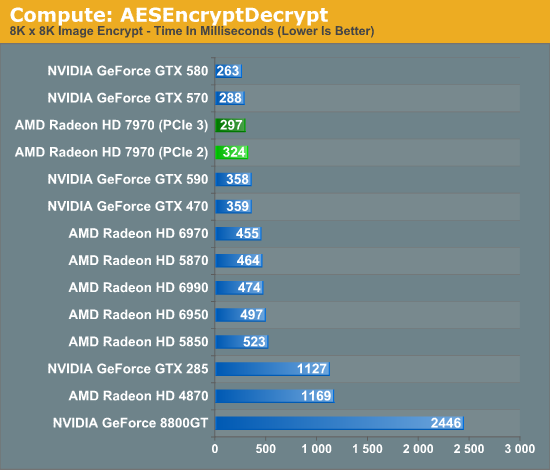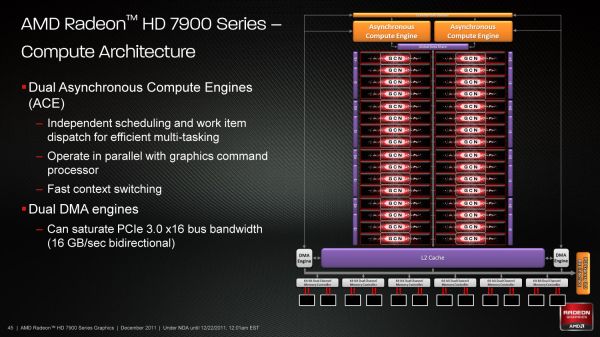AMD Radeon HD 7970 Review: 28nm And Graphics Core Next, Together As One
by Ryan Smith on December 22, 2011 12:00 AM EST- Posted in
- GPUs
- AMD
- Radeon
- ATI
- Radeon HD 7000
PCI Express 3.0: More Bandwidth For Compute
It may seem like it’s still fairly new, but PCI Express 2 is actually a relatively old addition to motherboards and video cards. AMD first added support for it with the Radeon HD 3870 back in 2008 so it’s been nearly 4 years since video cards made the jump. At the same time PCI Express 3.0 has been in the works for some time now and although it hasn’t been 4 years it feels like it has been much longer. PCIe 3.0 motherboards only finally became available last month with the launch of the Sandy Bridge-E platform and now the first PCIe 3.0 video cards are becoming available with Tahiti.
But at first glance it may not seem like PCIe 3.0 is all that important. Additional PCIe bandwidth has proven to be generally unnecessary when it comes to gaming, as single-GPU cards typically only benefit by a couple percent (if at all) when moving from PCIe 2.1 x8 to x16. There will of course come a time where games need more PCIe bandwidth, but right now PCIe 2.1 x16 (8GB/sec) handles the task with room to spare.
So why is PCIe 3.0 important then? It’s not the games, it’s the computing. GPUs have a great deal of internal memory bandwidth (264GB/sec; more with cache) but shuffling data between the GPU and the CPU is a high latency, heavily bottlenecked process that tops out at 8GB/sec under PCIe 2.1. And since GPUs are still specialized devices that excel at parallel code execution, a lot of workloads exist that will need to constantly move data between the GPU and the CPU to maximize parallel and serial code execution. As it stands today GPUs are really only best suited for workloads that involve sending work to the GPU and keeping it there; heterogeneous computing is a luxury there isn’t bandwidth for.
The long term solution of course is to bring the CPU and the GPU together, which is what Fusion does. CPU/GPU bandwidth just in Llano is over 20GB/sec, and latency is greatly reduced due to the CPU and GPU being on the same die. But this doesn’t preclude the fact that AMD also wants to bring some of these same benefits to discrete GPUs, which is where PCI e 3.0 comes in.
With PCIe 3.0 transport bandwidth is again being doubled, from 500MB/sec per lane bidirectional to 1GB/sec per lane bidirectional, which for an x16 device means doubling the available bandwidth from 8GB/sec to 16GB/sec. This is accomplished by increasing the frequency of the underlying bus itself from 5 GT/sec to 8 GT/sec, while decreasing overhead from 20% (8b/10b encoding) to 1% through the use of a highly efficient 128b/130b encoding scheme. Meanwhile latency doesn’t change – it’s largely a product of physics and physical distances – but merely doubling the bandwidth can greatly improve performance for bandwidth-hungry compute applications.
As with any other specialized change like this the benefit is going to heavily depend on the application being used, however AMD is confident that there are applications that will completely saturate PCIe 3.0 (and thensome), and it’s easy to imagine why.
Even among our limited selection compute benchmarks we found something that directly benefitted from PCIe 3.0. AESEncryptDecrypt, a sample application from AMD’s APP SDK, demonstrates AES encryption performance by running it on square image files. Throwing it a large 8K x 8K image not only creates a lot of work for the GPU, but a lot of PCIe traffic too. In our case simply enabling PCIe 3.0 improved performance by 9%, from 324ms down to 297ms.

Ultimately having more bandwidth is not only going to improve compute performance for AMD, but will give the company a critical edge over NVIDIA for the time being. Kepler will no doubt ship with PCIe 3.0, but that’s months down the line. In the meantime users and organizations with high bandwidth compute workloads have Tahiti.











292 Comments
View All Comments
Zingam - Thursday, December 22, 2011 - link
And at the time when it is available in D3D. AMD's implementation won't be compatible... :D That's sounds familiar. So will have to wait for another generation to get the things right.Ryan Smith - Thursday, December 22, 2011 - link
As for your question about FP64, it's worth noting that of the FP64 rates AMD listed for GCN, "0" was not explicitly an option. It's quite possible that anything using GCN will have at a minimum 1/16th FP64.Sind - Thursday, December 22, 2011 - link
Excellent review thanks Ryan. Looking forward to see what the 7950 performance and pricing will end up. Also to see what nv has up their sleeves. Although I can't shake the feeling amd is holding back.chizow - Thursday, December 22, 2011 - link
Another great article, I really enjoyed all the state-of-the-industry commentary more than the actual benchmarks and performance numbers.One thing I may have missed was any coverage at all of GCN. Usually you guys have all those block diagrams and arrows explaining the changes in architecture. I know you or Anand did a write-up on GCN awhile ago, but I may have missed the link to it in this article. Or maybe put a quick recap in there with a link to the full write-up.
But with GCN, I guess we can close the book on AMD's past Vec5/VLIW4 archs as compute failures? For years ATI/AMD and their supporters have insisted it was the better compute architecture, and now we're on the 3rd major arch change since unified shaders, while Nvidia has remained remarkably consistent with their simple SP approach. I think the most striking aspect of this consistency is that you can run any CUDA or GPU accelerated apps on GPUs as old as G80, while you even noted you can't even run some of the most popular compute apps on 7970 because of arch-specific customizations.
I also really enjoyed the ISV and driver/support commentary. It sounds like AMD is finally serious about "getting in the game" or whatever they're branding it nowadays, but I have seen them ramp up their efforts with their logo program. I think one important thing for them to focus on is to get into more *quality* games rather than just focusing on getting their logo program into more games. Still, as long as both Nvidia and AMD are working to further the compatibility of their cards without pushing too many vendor-specific features, I think that's a win overall for gamers.
A few other minor things:
1) I believe Nvidia will soon be countering MLAA with a driver-enabled version of their FXAA. While FXAA is available to both AMD and Nvidia if implemented in-game, providing it driver-side will be a pretty big win for Nvidia given how much better performance and quality it offers over AMD's MLAA.
2) When referring to active DP adapter, shouldn't it be DL-DVI? In your blurb it said SL-DVI. Its interesting they went this route with the outputs, but providing the active adapter was definitely a smart move. Also, is there any reason GPU mfgs don't just add additional TMDS transmitters to overcome the 4x limitation? Or is it just a cost issue?
3) The HDMI discussion is a bit fuzzy. HDMI 1.4b specs were just finalized, but haven't been released. Any idea whether or not SI or Kepler will support 1.4b? Biggest concern here is for 120Hz 1080p 3D support.
Again, thoroughly enjoyed reading the article, great job as usual!
Ryan Smith - Thursday, December 22, 2011 - link
Thanks for the kind words.Quick answers:
2) No, it's an active SL-DVI adapter. DL-DVI adapters exist, but are much more expensive and more cumbersome to use because they require an additional power source (usually USB).
As for why you don't see video cards that support more than 2 TMDS-type displays, it's both an engineering and a cost issue. On the engineering side each TMDS source (and thus each supported TMDS display) requires its own clock generator, whereas DisplayPort only requires 1 common clock generator. On the cost side those clock generators cost money to implement, but using TMDS also requires paying royalties to Silicon Image. The royalty is on the order of cents, but AMD and NVIDIA would still rather not pay it.
3) SI will support 1080P 120Hz frame packed S3D.
ericore - Thursday, December 22, 2011 - link
Core Next: It appears AMD is playing catchup to Nvidia's Cuda, but to an extent that halves the potential performance metrics; I see no other reason why they could not have achieved at varying 25-50% improvement in FPS. That is going to cost them, not just for marginally better performance 5-25%, but they are price matching GTX 580 which means less sales though I suppose people who buy 500$ + GPUs buy them no matter what. Though in this case, they may wait to see what Nvidia has to offer.Other New AMD GPUs: Will be releasing in February and April are based on the current architecture, but with two critical differences; smaller node + low power based silicon VS the norm performance based silicon. We will see very similar performance metrics, but the table completely flips around: we will see them, cheaper, much more power efficient and therefore very quiet GPUs; I am excited though I would hate to buy this and see Nvidia deliver where AMD failed.
Thanks Anand, always a pleasure reading your articles.
Angrybird - Thursday, December 22, 2011 - link
any hint on 7950? this card should go head to head with gtx580 when it release. good job for AMD, great review for Ryan!ericore - Thursday, December 22, 2011 - link
I should add with over 4 billion transistors, they've added more than 35% more transistors but only squeeze 5-25% improvement; unacceptable. That is a complete fail in that context relative to advancement in gaming. Too much catchup with Nvidia.Finally - Thursday, December 22, 2011 - link
...that saying? It goes like this:If you don't show up for a race, you lose by default.
Your favourite company lost, so their fanboys may become green of envydia :)
Besides that - I'd never shell out more than 150€ for a petty GPU, so neither company's product would have appealed to me...
piroroadkill - Thursday, December 22, 2011 - link
Wait, catchup? In my eyes, they were already winning. 6950 with dual BIOS, unlock it to 6970.. unbelievable value.. profit??Already has a larger framebuffer than the GTX580, so...